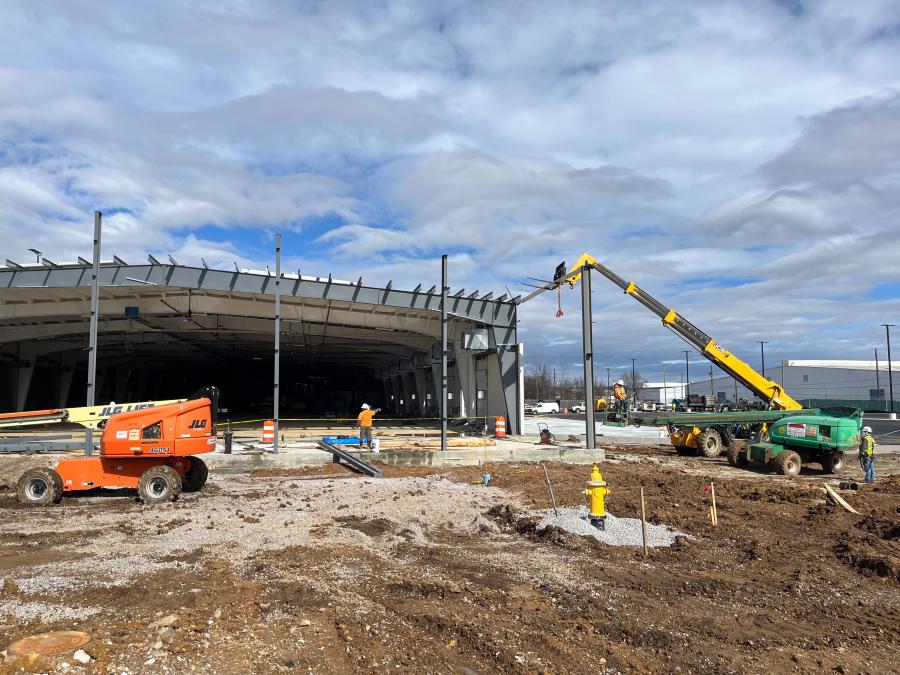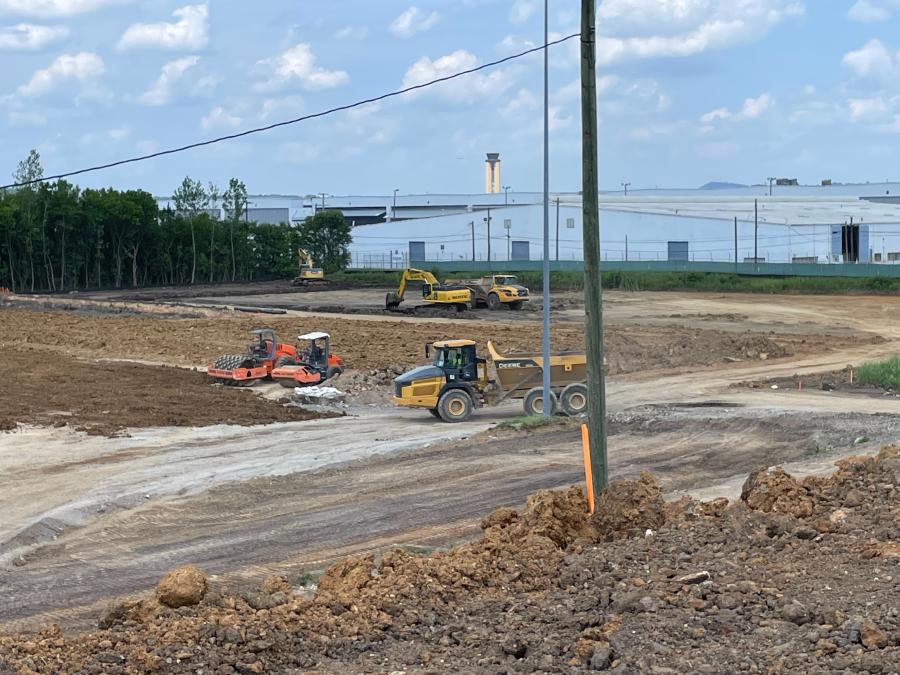Photo courtesy of Bold as a Lion Studios
Crews have put in long hours at times to stay on schedule.
In Alabama, a $28 million project designed to accommodate weekly international cargo flights from Stuttgart, Germany, to Birmingham-Shuttlesworth International Airport (BHM) is nearing completion. The roughly 53,000-sq.-ft. air cargo facility is constructed from pre-engineered metal with a wind load of 107 mph.

Photo courtesy of Stone Building Company
“Several years ago, the Birmingham Airport Authority [BAA] began to detect an increasing demand for cargo operations in central Alabama,” said Kim Ford, BAA vice president of communications. “This included a growing trend for logistics companies looking to operate out of ‘secondary airports,’ which refers to smaller airports that are less congested than the large hubs. When these companies go looking to partner with airports, they typically want to lease existing facilities.
“To be in the game, the BAA needed the right kind of facility in place. The board committed to designing and building a new facility so the BAA could leverage both existing infrastructure and the new building in negotiations with future operators.”
The project is 100 percent funded by BAA and should be completed by early summer. A ceremony to officially kick off construction took place in May 2023.
Ford noted that Birmingham is an ideal site for additional cargo business.
“BHM is located in central Alabama, with great access to major highway and interstate systems. BHM has the infrastructure to accommodate additional cargo traffic on the airfield. BHM does not have the congestion found at larger hub airports in the region, which means that companies can get goods in more quickly and on to their destination more efficiently.”
The main impact to day-to-day activity is that the existing air cargo apron is cut down to half its capacity while concrete reconstruction and apron expansion is under way. This is one of the many areas where collaboration between contractor, operators and airport operations is critical.
“The general contractor on this project is Stone Building Company,” Ford said. “Stone is a local company, which means that BAA’s investment is having the maximum economic impact on our local community. Stone earned the contract by being the lowest responsive and optimal bidder in a very structured and open process.”
Ford said for the most part, the work is going according to plan.
“We ran into some unforeseen challenges with utilities early in the project while getting to the base elevation. We found more wet, soggy conditions than expected, which required more excavation than originally anticipated.”
Ford added that to bring the project to life, it took the vision of the BAA board to anticipate the need for the facility and to begin to plan for it several years before breaking ground.
“The BAA could not have pursued this project, had it not been in a financial position to fund the project. Along with several years of planning, the BAA collaborated with interested, potential cargo partners whose customers were accepting of BHM as a future option.”
Ford said the airport’s partnership with global logistics leader Kuehne+Nagel (K+N) was announced in February 2023.

Photo courtesy of Stone Building Company
“K+N began weekly international cargo flights from Stuttgart, Germany, two months later, operating out of a temporary facility. K+N will lease the new facility once it is completed, and it will be home base for their operation. We couldn’t ask for a better partner. They are committed to growing their cargo business and customer base here in the automotive, pharma and aerospace sectors.”
According to Marcelo Lima, vice president of planning and development for the BAA, the biggest obstacle on the project — the unforeseen utility issues — required a significant amount of planning and coordination.
This included the relocation of a main sewer line.
“It’s a credit to the entire team on this project that we have worked through the challenges and kept the project moving forward.
“Right now, we are seeing the filtration vault take shape under the apron expansion area. This involves digging a huge, deep hole, pouring concrete sections in place and installing elements that will help filter water run-off from the site. The filtration vault was necessary to reduce water pollutants into the local waterways, due to the increased impermeable surface from the cargo apron expansion.”
The facility was constructed on what used to be a hill. To build on the site, the contractor had to remove the hill, condition the dirt and install the embankment back in place for the elevated building pad.
“In an effort to recycle the existing material, we over-excavated portions of the site and built it back up with the conditioned material. Approximately 60,000 cubic yards of dirt was excavated/removed for this project.”
As for working in a busy airport environment, said Lima, “We are always concerned about safety and security, particularly when embarking on a project like this one. This project is being completed on an active air cargo apron. That means that all vehicles, heavy equipment, construction activities, subs and schedules must be part of a detailed, approved plan that is communicated to all affected parties at all times.
“Additionally, tall equipment, such as cranes, must undergo an airspace analysis and be coordinated with the Federal Aviation Administration and Air Traffic Control. The BAA’s airport operations team carries the heavy task of constantly inspecting the construction site, to assure compliance with all safety and security measures. There are a lot of moving parts on a project like this.”
Crews have put in long hours at times to stay on schedule. Workers were tasked with running electrical conduit across active portions of the airfield. The work could only be performed at night.
Lima said a variety of machinery is needed to complete the assignment.
“We have relied on heavy equipment for many of the critical pieces of this project. This includes concrete pavers, excavators, temporary batch plant and cranes.”
The project has included the removal of approximately 15,000 sq. yds. of pavement (concrete and asphalt), approximately 15,900 sq. yds. of P-307 (6-in. cement-treated permeable base course) and 15,600 sq. yds. of P-501 (15-in. concrete pavement).
The facility consists of gable roof type. The interior of the structure is equipped with dock levelers at each loading dock and two scissor lifts and conveyor systems by McKenzie Handling Systems Inc.

Photo courtesy of Stone Building Company
“This project is about 50 percent concrete work,” said Lima. “Rebuilding and expanding the air cargo apron is a big undertaking and must be completed to standards established by the FAA.
The new building will have little effect on commercial airline or general aviation customers at the airport.
“The greatest impact will come over time, as the BAA continues to grow cargo business at the airport. This will only strengthen the airport’s strong financial performance, which will help the BAA fulfill the mission of being an economic generator for Birmingham and central Alabama.”
Lima added, “The new building represents a new line of business for BAA. Seeing the facility nearing completion is very exciting for the airport, the community and the future of the region.” CEG
Read the full article here











